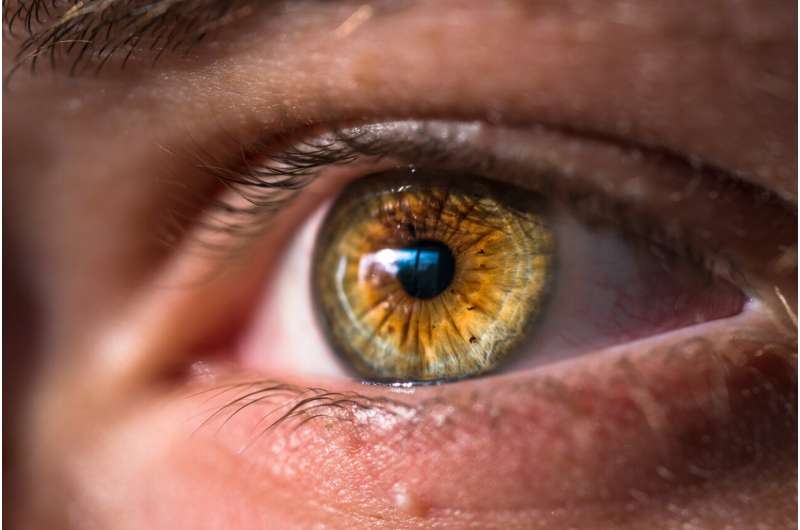
Three of the most common chronic eye conditions require regular medical checkups and injections into the eye by ophthalmology specialists to keep looming blindness at bay. A study by the University of Bern and the Inselspital in collaboration with an AI in eyecare startup now demonstrates that patients’ individual ideal frequency for these visits can quite accurately be predicted by machine learning—yielding a threefold benefit.
Age-related macular degeneration (AMD) is the most common cause of vision loss in people over 50. Up to 12 percent of those over 80 have the chronic disease. An estimated 16.4 million adults are affected by retinal vein occlusion (RVO) worldwide, a condition caused by a thrombosis of a retinal vein. It is the second most common cause of blindness from retinal vascular disease after diabetic retinopathy (DR). DR,in turn, is the leading cause of blindness in developed countries and affects up to 80 percent of people with more than 20 years of diabetes. It can lead to a swelling of the macula (diabetic macular edema, or DME), which may cause partial or complete vision loss.
All three conditions are treated by injections of a so-called anti-vascular endothelial growth factor (anti-VEGF) into the eye at intervals to slow down disease progress and prevent blindness. Because with eyesight, a central human sense is in jeopardy, patients are eager to know that they are being treated often enough to avoid rapid worsening. And doctors want to make sure they see each patient frequently enough not to miss important developments.
The challenge
With the aging population, cases of AMD, RVO or DME are globally on the rise, making it hard for specialized eye clinics to keep up with the growing demand for regular treatments. “As doctors, we want to give each patient the necessary attention and treatment frequency that they need,” says Sebastian Wolf, Head of the Ophthalmology Department of the Inselspital that currently sees 6,000 patients with AMD, RVO and DR. “But it is also an organizational challenge to meet all patients’ needs and be able to study all relevant eye imaging data to assess individual disease progression and take treatment decisions in the short time given.”
To monitor progression of the chronic eye conditions, Optical Coherence Tomography (OCT), an imaging tool that generates 3D images of the eye at extremely high resolution, is usually applied. In collaboration with the ARTORG Center for Biomedical Engineering Research, the Inselspital has developed automated OCT analysis tools based on artificial intelligence, which can assist eye doctors in the assessment of a whole patient OCT-set in just a few seconds. Together with RetinAI, a startup specialized in AI-based eye care technologies, they now have conducted a retrospective study of patients to assess how well AI can predict anti-VEGF treatment demand from the start.
The setup
The study looked at OCT-data from 340 patients with AMD and 285 patients with RVO or DME, treated with anti-VEGF at the Inselspital between 2014 and 2018. Based on morphological features automatically extracted from the OCT volumes at baseline and after two consecutive visits, as well as patient demographic information, two machine learning models were trained to predict the probability of the long-term treatment frequency demand of a new patient (one for AMD and one for RVO and DME).
Based on the first three visits, it was possible to predict if a patient had a low or a high treatment demand for both the AMD and the RVO & DME groups with similar high accuracy. More importantly, the study revealed that it is possible to predict reasonably well at the initial visit and even before the first injection if a patient will less often require injections.
Three advantages
“We have shown that machine learning classifiers can predict treatment demand when a patient is first diagnosed with a chronic eye disease,” says Mathias Gallardo, postdoctoral researcher the ARTORG AI in Medical Imaging (AIMI) lab and member of the new Center for Artificial Intelligence in Medicine (CAIM). “Hence, artificial intelligence may assist in establishing patient-specific treatment plans for the most common chronic eye conditions in the near future.”
Planning the ideal treatment frequency for each patient has multiple benefits. Firstly, patients can be sure their disease is being treated in the best way possible without subjecting them to overly frequent visits and unpleasant injections into the eye. Secondly, individualized planning can help clinics cope with ever growing patient numbers allowing for the highest possible capacity utilization of specialized medical skills and infrastructure. Thirdly, objectivized on-demand planning helps avoid overprovision and can lead to improved cost-efficiency and fewer healthcare expenditures.
High-yield confluence of clinical, data science, and industrial research
This study illustrates once more the proven eye-level collaboration between clinicians and data scientists of the Inselspital and the ARTORG Center, which produces technology solutions suitable for everyday use because they were designed directly as a response to clinical needs. A further important aspect to provide a roadmap for the clinical implementation of such technology was the startup RetinAI.
Source: Read Full Article
